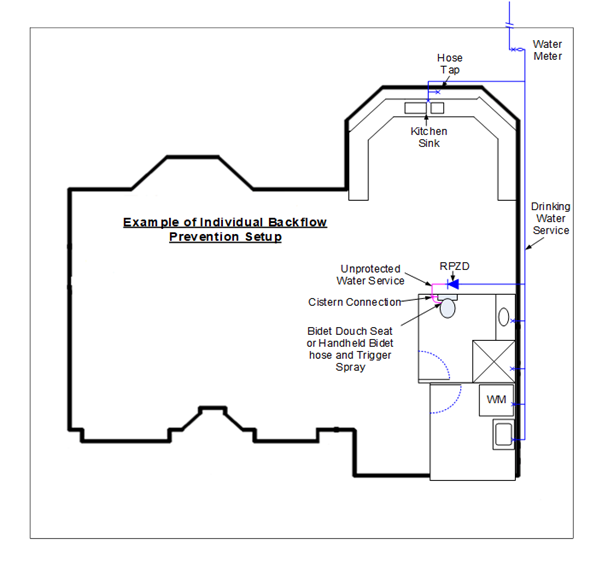| Advisory note | 21/2021 |
| For | Licensees / Contractors / the Plumbing and Drainage Industry |
| Scope | Applies to all metropolitan and regional areas in NSW |
Issue
With the adoption of the Plumbing Code of Australia (PCA) 2022 on the 1st May 2023, NSW Fair Trading is informing the plumbing and drainage industry to the new requirements to cross connection and backflow control that will take effect.
Code detail
The PCA 2022 is available to be viewed on the Australian Building Codes Board (ABCB) website. See the below links to the specific parts covering cross connection control and cross connection hazards:
Regulatory Commentary
Part B5 of PCA 2022 prescribes the Deemed-to-Satisfy requirements where a hazard exists for water or contaminants to enter a drinking water service, non-drinking water service and/or rainwater service from:
- Another water service (drinking water, non-drinking water, rainwater)
- An alternative water supply
- A swimming pool
- Pipes, fixtures or specialist equipment (including boilers and pumps) containing chemicals, liquids, gases or other substances which may be harmful to health or safety
Individual and Zone Hazard scenarios are prescribed in Specification 41. Specification 41 lists out common scenarios of hazards.
A prescribed individual or zone hazard must have an appropriate backflow prevention device selected and installed in accordance with Section 4 of AS/NZS3500.1:2021. The device selected must be suitable for the hazard rating, and protect as required for back pressure and/or back siphonage.
Where a hazard scenario is not prescribed in Specification 41, the Performance Requirements of Part B5 are to be met, including the determination of the hazard rating using the Verification Method as well as the submission of a Performance Solution. In lieu of submitting a Performance Solution for a hazard that is not described, a default high hazard device suitable to protect against back pressure and back siphonage can be used (eg RPZD, RBT, RAG).
Bidet douche seats
In all instances a Bidet Douche Seat shall be supplied from a drinking water supply only.
Specification 41 – S41C4 Individual Protection prescribes that each Bidet Douche Seat where the outlet in any position is not 25mm above the overflow level of the pan requires individual high hazard protection.
In some instances a Bidet Douche Seat has a suitable high hazard protection integral of the seat. The integral high hazard protection usually in the form of an Air-Gap, or Atmospheric Vacuum Breaker (AVB) must be listed on the Watermark Product Description which can be found on the Watermark Product Database
In all instances, where the Watermark Product Description does not indicate to contain a high hazard protection integral of the Bidet Douche Seat, a high hazard device such as a Reduced Pressure Zone Device (RPZD) must be installed. The high hazard device must be installed to individually to protect against the hazard at each toilet douche seat. See below example installation diagram:
Handheld bidet hoses and trigger sprays:
In all instances a handheld bidet hose and trigger spray shall be supplied from a drinking water supply only.
A high hazard device such as a Reduced Pressure Zone Device (RPZD) must be installed with a handheld bidet hose and trigger spray. The high hazard device must be installed to individually to protect against the hazard at each handheld bidet hose and trigger spray.
See below example installation diagram:

NSW Variations
NSW Variations to the PCA 2022 Cross connection control requirements are in place for Clauses B5D6 and B5D7.
B5D6 Rainwater
Drinking water and non-drinking water must:
(a) be zone protected from above ground, buried, or partially buried rainwater tank in Class 1 Buildings, utilising a non-testable device: or
(b) comply with AS/NZS 3500.1(2018) Clause 16.4 and Table 16.4 for all other building classes
Applications
B5D6 applies to scenarios not covered by S41C6(1)(b).
B5D7 Cooling tower water service
Water systems permanently attached to cooling towers backflow prevention shall be positioned so that:
(a) cooling tower air gap must be measured from the rim of the cooling tower basin: and
(b) if a drinking water service to the cooling tower passes through the basin, the service pipe must be provided with a double wall protection; and
(c) if a fast fill connection is required, the fast fill line shall terminate externally to the unit, with an air gap over wither the basin or a tundish.
Notes
See NSW Figure B5D7 for typical cooling tower connections.
Containment protection
Regulations issued under water supply legislation, and/or rules set by the Network Utility Operator (NUO), may prescribe containment protection which differs from Specification 41.
If this occurs, then those NUO regulations and/or rules should be followed.
Note:
Information contained within this document is current as of May 2023 and refers to codes and standards current at the time of writing.
NSW Fair Trading disclaims any liability (including for negligence) to any person in respect of anything done, or not done, by that person in whole or partial reliance on any of the information in this advisory note.